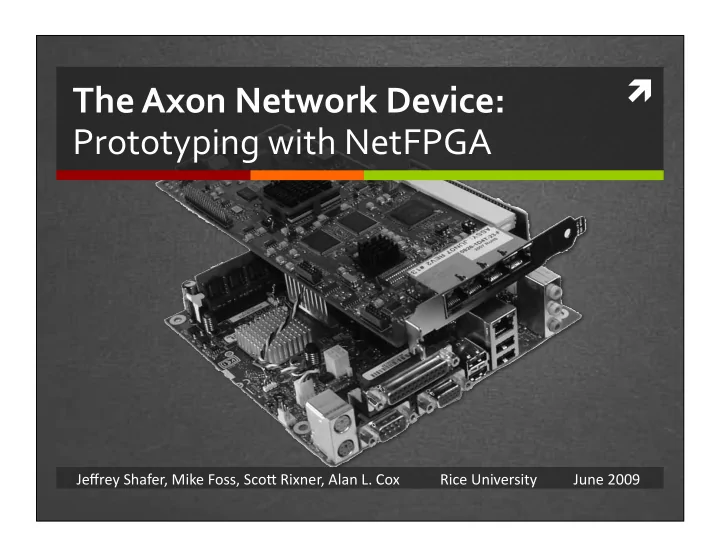

The Axon Network Device: Prototyping with NetFPGA Jeffrey Shafer, Mike Foss, Sco3 Rixner, Alan L. Cox Rice University June 2009
2 Networks Ethernet is a popular “plug and play” network Big challenge – scalability (i.e. broadcast) Big challenge – performance (i.e. spanning tree) Host Locate H2 ARPs are flooded! (ARP) S S H1 Ethernet Switch (S) Redundant S S paths are disabled! S S H2 Jeffrey Shafer ‐ Rice University June 20th, 2009
3 Raising the Bar Many researchers have proposed designs to solve Ethernet problems But, they evaluate their soluRons in simula'on We have designed a new network device (the Axon ) that improves Ethernet and have built a prototype for evaluaRon The prototype proves that our design is pracIcal and implementable Jeffrey Shafer ‐ Rice University June 20th, 2009
4 Axon Networks Vision for a new network infrastructure Replace Ethernet switches with Axons Remove IP routers from network core Only used to communicate with other networks (their tradiRonal role) Hosts communicate with Axons via tradiRonal Ethernet Standard NICs, PHYs, protocols for full compaRbility Axons communicate with other Axons via a new protocol Source‐routed Ethernet Uses standard Ethernet physical layer (PHYs, cables) Jeffrey Shafer ‐ Rice University June 20th, 2009
5 Source‐Routed Ethernet Backwards compaRbility with tradiRonal Ethernet Source‐Routed Packet Network appears to hosts as a giant switched Ethernet segment Data Transparent packet rewriRng Imagine sending packet from Host A to Host Z… A First Axon on path strips standard header and replaces it with hop‐ by‐hop route list (“source route”) used for transport 1 Final Axon restores the original header Axon design pushes complexity to the network edge 2 State is stored by edge Axons Axons in network core only process the source routes Routes are determined by edge Axons (connected to host) 3 Enables opportuniRes for the edge Axons to provide security or virtual networks by carefully choosing routes Z Jeffrey Shafer ‐ Rice University June 20th, 2009
6 Overview Designed the Axon , a new network device Axons replace Ethernet switches, but are be3er (performance, scalability, …) Built Axon prototypes on exisRng NetFPGA pla`orm Easy to use + inexpensive Current work – Performance & Backwards CompaRbility Demonstrated using Axon prototype Future work – Network Scalability (up to 1 million hosts) Intend to demonstrate using a hybrid prototype/simulator infrastructure Jeffrey Shafer ‐ Rice University June 20th, 2009
7 Why Prototype? Compelling demonstraRons Does the Axon architecture provides full compaRbility with unmodified hosts? Can we translate between tradiRonal Ethernet and source‐routed Ethernet at full network speed? (while using inexpensive / prac'cal hardware?) Compelling experiments How does the performance of Axons compare to Ethernet switches and IP routers when using real network hosts? Jeffrey Shafer ‐ Rice University June 20th, 2009
8 Prototype Platform ‐ NetFPGA Integrated development environment for network systems architecture research and educaRon Developed by team at Stanford Inexpensive ($499 academic price) Includes PCI board and FPGA reference designs 4‐port NIC, Ethernet Switch, and IP router Designs provide all soiware and hardware components, including Verilog and ModelSim libraries Jeffrey Shafer ‐ Rice University June 20th, 2009
9 NetFPGA PCI Board PHY Virtex‐II SRAM DDR Pro 50 4‐port FPGA Gigabit Ethernet Spartan FPGA PCI Interface – 32‐bit, 33‐Mhz Jeffrey Shafer ‐ Rice University June 20th, 2009
10 Prototype Architecture ‐ Data Plane Data Plane ‐ High‐speed packet forwarding on FPGA Reused exisRng NetFPGA components PCI card Verilog design library (e.g. DMA transfer engine) ModelSim test suite FPGA programming uRliRes Added new modules to FPGA (14,000 lines of Verilog) Cut‐through packet switching engine Input/output port units to transparently convert between tradiRonal and source‐routed Ethernet at line rate Jeffrey Shafer ‐ Rice University June 20th, 2009
11 Prototype Architecture ‐ Control Plane Control Plane ‐ Management tasks on processor Intel Atom motherboard Low‐power + low‐cost + x86 compaRbility Don’t need a fast processor for control plane Reused exisRng NetFPGA components Linux (x86) device driver Programming and management tools Wrote new 6,000 line control program in C Determine network topology Calculate and establish source‐routes Manage Axon hardware Jeffrey Shafer ‐ Rice University June 20th, 2009
12 Axon Prototype Jeffrey Shafer ‐ Rice University June 20th, 2009
13 Prototype Network Host Host Host Unmodified devices Windows, Mac, Linux hosts Data Plane Data Plane Data Plane Axon Wireless A.P. Control Control Control Netgear switch Plane Plane Plane Cisco router Standard protocols Data Plane Data Plane Data Plane ARP, DHCP, Axon Control Control Control Ethernet, … Plane Plane Plane Transparent compaIbility! Campus / Public Gateway Switch A.P. Internet Router Jeffrey Shafer ‐ Rice University June 20th, 2009
14 NetFPGA Advantages Rapid development Leverage the Verilog library, ModelSim environment, and proven hardware The Axon prototype was a summer project Portability (x86‐based control soiware) Leverage this advantage for future simulator work Jeffrey Shafer ‐ Rice University June 20th, 2009
15 NetFPGA Drawbacks Only 4 Ethernet ports – limits topologies FPGA is 76% full Prototype limited to 16‐entry CAM (CAM is used to translate between desRnaRon MAC address and source route at edge Axon) To show scalability on large networks, a much larger CAM would be needed (too big for FPGA) Have alternate design for prototype that uses a direct lookup method based on MAC address Jeffrey Shafer ‐ Rice University June 20th, 2009
16 Axon Hybrid Simulator Jeffrey Shafer ‐ Rice University June 20th, 2009
17 Network Scalability How can we show that the Axon design scales to networks with 1 million+ hosts? Build / deploy vast numbers of prototypes? Propose a hybrid prototype / simulator infrastructure instead Use a few real hosts and real Axons Connect them to thousands of simulated Axons (which run the same x86 control soiware) Jeffrey Shafer ‐ Rice University June 20th, 2009
Recommend
More recommend